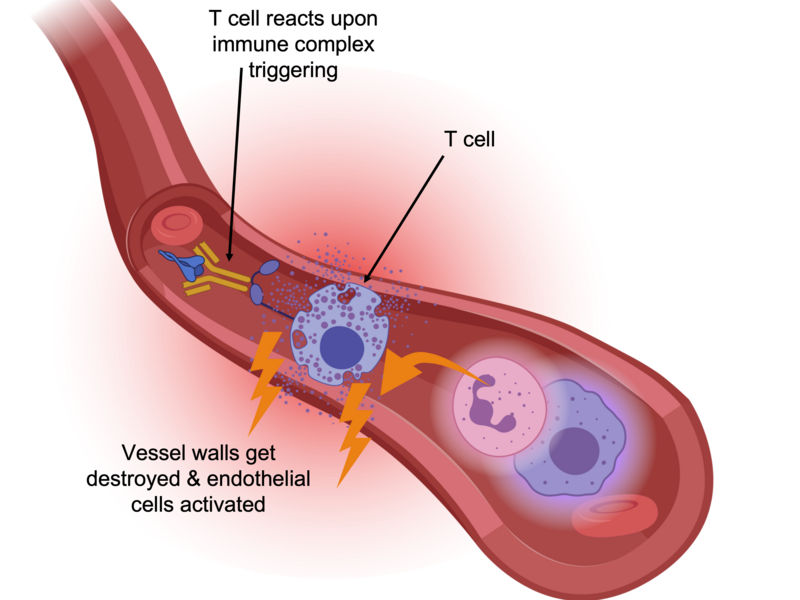The fatal role of T cells in COVID-19
Safety mechanism is put out of action
Scientists from the Berlin Institute of Health at Charité (BIH), together with colleagues from Charité – Universitätsmedizin Berlin and the university hospitals in Bonn and Aachen, have found a type of immune cells that is particularly active in severely ill Covid-19 patients. The CD16 positive T cells have an increased cytotoxic effect, especially on the inner cell layer of blood vessels. Their presence, along with complement system factors, is associated with a highly fatal outcome of the disease.

BIH/Birgit Sawitzki
It is now virtually certain that a dysfunctional immune system plays a key role in severe COVID-19: Overactive immune cells attack and destroy the body’s own tissue, even if the actual viral infection has already been contained or even overcome. Professor Birgit Sawitzki, head of the Translational Immunology Department at the BIH, is particularly interested in the role of T cells in SARS-CoV-2 infection. “T cells are the conductors of the whole orchestra of immune cells and signaling molecules,” she explains. “T helper cells make it possible to develop a targeted defense using tailored antibodies, T killer cells specifically destroy infected or malignant cells in the body, and regulatory T cells make sure everything stays in sync. Unfortunately, certain T cells are responsible for a particularly severe course of COVID-19.”
Safety mechanism is put out of action
“We knew that SARS-CoV-2 infection causes T cells to proliferate that specifically recognize and respond to the spike protein – even in patients who develop a severe disease course. So the severe course of the disease is apparently not due to the immune response being too weak,” explains Philipp Georg, the co-lead author of the current paper and a PhD student with Prof. Leif Erik Sander of Charité’s Department of Infectious Diseases and Respiratory Medicine. Sander played a key role in the research and led the clinical part of the study, among other contributions. To find out what role T cells play in COVID-19, the scientists used single-cell analyses to examine the blood of patients with mild or severe COVID-19 disease and compared it with the blood of healthy subjects and of patients with other viral infections. They discovered T cells carrying the CD16 molecule on their surface in individuals with severe COVID-19. “This was a surprise to the immunology community,” Sawitzki reports, “because CD16 is actually expected on cells of the innate immune system like natural killer cells or monocytes, but not on T cells that belong to the acquired or specific immune system.”
CD16 helps cells of the innate immune system recognize and kill virus-infected cells in the body. The molecule detects antibodies bound to virus-infected cells and then stimulates immune cells to release cytolytic enzymes, which destroy the virus-infected cells. Yet T cells are not in need of such help. “T cells identify virus-infected cells through their T cell receptor, which specifically binds to presented viral components, thereby stimulating the T cell to kill the target cell. Additional activation by CD16, independent of the T cell receptor, can significantly increase the destructive function of T cells,” Sawitzki explains. “This is dangerous because T cells actually have a built-in safety mechanism: They use their T cell receptors to track down foreign protein substances, so their activity is directed only against infected or altered body cells. Activation via CD16 overrides this safety mechanism, enabling non-infected vascular cells to be attacked.”
The complement system is also involved
The researchers observed in laboratory experiments that upon contact with antibodies, the CD16 positive T cells released cytotoxic molecules and damaged pulmonary vascular cells. In collaboration with researchers from Aachen, they also discovered CD16-positive T cells in the lungs of deceased COVID-19 patients. “This confirmed our suspicion that these cells play a fatal role in the course of COVID-19 disease,” explains Rosario Astaburuaga Garcia, one of the lead authors and a PhD student with Professor Nils Blüthgen of the Institute of Pathology at Charité and of the Integrative Research Institute for the Life Sciences at Humboldt-Universität zu Berlin. “We were surprised by the fact that activated CD16 positive T cells are not found in individuals with other severe infections such as HIV or hepatitis.”
While searching for the origin of CD16 positive T cells, the scientists came across the so-called complement system: This encompasses over 30 proteins that are dissolved in the blood plasma to help fend off microorganisms. They are activated in the course of the immune response by various mechanisms, such as by bound antibodies, and lead to the elimination of infected cells. “We have found that certain components of this system are abundantly produced in patients with a severe course of COVID-19 and contribute to the emergence of CD16 positive T cells. Here we seem to have discovered an important new link,” Sawitzki suspects. “If this link is confirmed, inhibiting the complement system could potentially help reduce severe courses to a minimum.” This is precisely the avenue that the scientists now want to explore further.
Original publication
Other news from the department science
Most read news
More news from our other portals
See the theme worlds for related content
Topic World Cell Analysis
Cell analyse advanced method allows us to explore and understand cells in their many facets. From single cell analysis to flow cytometry and imaging technology, cell analysis provides us with valuable insights into the structure, function and interaction of cells. Whether in medicine, biological research or pharmacology, cell analysis is revolutionizing our understanding of disease, development and treatment options.

Topic World Cell Analysis
Cell analyse advanced method allows us to explore and understand cells in their many facets. From single cell analysis to flow cytometry and imaging technology, cell analysis provides us with valuable insights into the structure, function and interaction of cells. Whether in medicine, biological research or pharmacology, cell analysis is revolutionizing our understanding of disease, development and treatment options.






















































